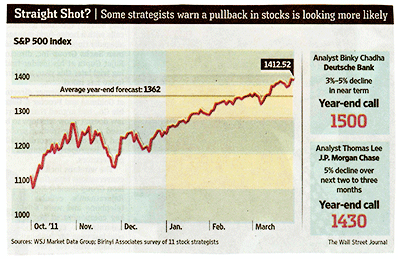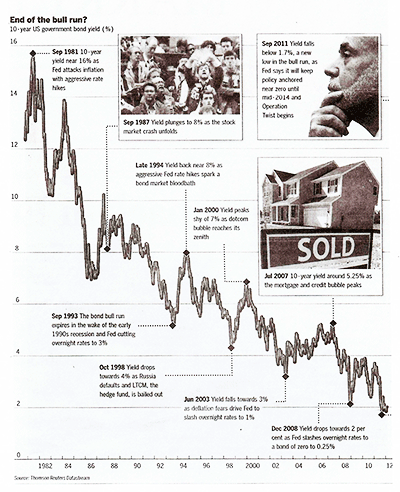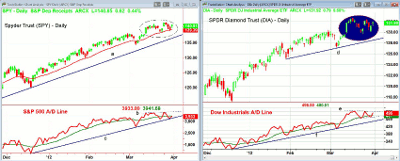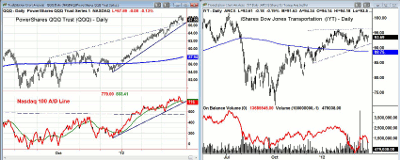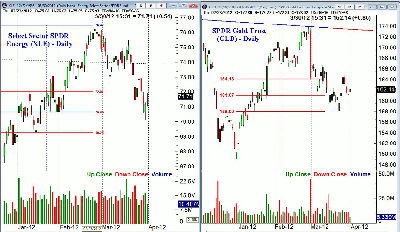Risk of a deeper correction remains high despite a holiday-shortened week. Watch for technical warning signs, as well as a potential topping formation in the bond market, writes Tom Aspray.
Stocks finished the week a bit lower, but once again, the heavier selling last Thursday was well supported. This past week started off with a bang, as comments from Fed chairman Ben Bernanke suggested that he was ready to help in order to increase job growth. This sparked impressive one-day gains and led the Nasdaq Composite to reach its highest closing level since November 2000.
Stocks then declined for the next three days, and many on Wall Street expected a further correction still. Early in 2012, many strategists were not very bullish for stocks in 2012.
The most bullish has been Binky Chadra of Deutsche Bank, who was looking for the S&P to reach 1500. As the Wall Street Journal chart below indicates, the median forecast was for the S&P 500 to end the year at 1362, which is more than 3% below Friday's close. Therefore, some of these strategists are now looking for a 3%-5% correction before the market can resume its uptrend. Such a correction could give some the opportunity to raise their forecasts.
So what should investors expect in April? Over the last 40 years, the month of April has been one of the better months, averaging a gain of 1.56%. Typically, the period from November to May is the best time for the stock market.
I have found over the years that when the majority expects a correction, it often comes from higher levels and is more severe than many will tolerate. Technically, Friday's positive action suggests that this may presently be the case.
Some of the important market sectors have already had their corrections and could easily spur another rally to significant new highs. If the major averages do break out of their recent trading ranges, we could then see another 2%-3% on the upside. This might be enough to swing the other sentiment measures to more extreme levels.
Currently, the sentiment measures have become a bit more positive, as the number of bullish financial newsletter writers rose to 50.5%, up from 43.4% just three weeks ago.
The number of bearish individual investors dropped 2.3%, to 25.5% last week, while the number of bulls was 42.5%. This is well below what is seen at significant market tops, although the newsletter writers are getting closer. It should be noted that these sentiment measures only give very good signals one or two times a year and always need to be supported by the technical action.
The other main focus is now on the bond markets, both in the US and overseas. Rates surged early in March but have now come back down. I wrote here on Thursday that the technical action of the inverse bond ETFs indicates they may now be reaching a critical juncture, as they have pulled back to test key support.
This wonderful long-term chart of ten-year note yields from the Financial Times dates back to 1982, when yields peaked near 16%. If you are not familiar with the history of the bond market, this chart illustrates some of the key turning points.
Noted on the chart is the 1998 drop towards a yield of 4%, which came in reaction to the collapse of the hedge fund Long-Term Capital Management, which I also discussed in Friday's Charts in Play column.
Higher rates in the US would boost the dollar and could help to complete the long-term bottom formation that I will discuss later. In the overseas markets, another drop in the German bunds could make it more difficult for European banks to recover, as it would adversely impact their balance sheets.
NEXT: Eurozone Problems, Data to Watch This Week
|pagebreak|The Eurozone problems have been on the back burner for the past few weeks, but that may not last much longer. The rescue fund was boosted to EUR 700 million late last week, but many still think it needs to reach EUR one trillion.
The inflation rate is still too high, and riots in Spain over further austerity measures are keeping many on edge. Though the charts of major European stock markets like the German Dax and the French CAC-40 look much stronger than we might expect, they are badly lagging the US market.
The US economic data last week was mixed, as pending home sales were weaker than expected, but the good news was that home prices declined less than the initial projections. Durable goods were weaker than anticipated, while the GDP data came in as expected.
In this holiday-shortened week (the markets are closed for Good Friday), there is plenty of data for the market to contemplate, ending with the monthly jobs report on Friday. On Monday, we will get the widely-watched ISM Manufacturing Index and construction spending.
On Tuesday, factory orders and the release of the FOMC meeting minutes will be out, followed on Wednesday by the ISM Non-Manufacturing Report and ADP Employment Report.
Weekly jobless claims come out on Thursday, as do the latest numbers on chain store sales.
WHAT TO WATCH
Sharp gains last Monday clearly resolved the prior week's indecision. The early drop last Thursday took some of the major averages back to their first key levels of support, which now appear to have held. Friday's higher close supports the positive outlook.
Though the Advance/Decline (A/D) line on the NYSE Composite still shows a short-term negative divergence, this is not the case for the A/D lines on the S&P 500, Dow Industrials, and Nasdaq 100. This supports a test, if not a breakout above, the March highs this week.
Given the holiday-shortened week and the monthly jobs report coming out on Friday when the markets are closed, risk remains quite high. I have been concerned that we could see a disappointing monthly jobs report in the not-too-distant future, and that could come this week.
S&P 500
The daily chart of the Spyder Trust (SPY) shows the 12-day trading range, as the rising 20-day exponential moving average (EMA) was tested again last Thursday. There is support now at $138.55-$139.09 with resistance at $141.83, which was last Tuesday's early high.
A move above this level would project a move to the $145.50 area, which corresponds nicely to the major Fibonacci projection target at $145.27.
The S&P 500 A/D line has moved back above its weighted moving average (WMA) and held above the prior lows last week. It did make marginal new highs, confirming the price action. The uptrend in the A/D line from late last year was tested last week, and a decisive break of this uptrend would be negative and signal that a deeper correction was underway.
A daily close below $138-$138.55 would indicate a test of the early-March lows at $134.36, or 1340 on the S&P 500.
Dow Industrials
The flag formation, or continuation pattern, is more evident on the SPDR Diamonds Trust (DIA). There is resistance at $132.61 and support at $129.71, so the range is 2.9 points wide. Therefore, a close above $132.61 will project a move to $135.51, which should be enough to bring some money in off the sidelines.
The Dow Industrials’ A/D line also shows a flag formation (dashed lines) that was nearly completed on Friday. Positive action on Monday should do it. The A/D line has more important support at the uptrend, line e. There is more important support now in the $127-$128.50 area, line d.
NEXT: Small Caps, Technology, and Other Sectors to Watch
|pagebreak|Russell 2000
The iShares Russell 2000 Index Fund (IWM) also made marginal new highs last week and is looking a bit better, technically. A strong close above the $84.70 level would be a sign that a stronger rally was underway.
The next major area of resistance is at $86.81, which was the 2011 high. There is important support now in the $81-$81.40 area.
Nasdaq-100
The PowerShares QQQ Trust (QQQ), which tracks the Nasdaq 100 Index, made convincing new highs last week at $68.49 and continues to act quite strong. The break through the upper trend resistance (line a) caused prices to accelerate on the upside.
There is next resistance in the $69-$70 area and then at $71.50.
The Nasdaq-100 Advance/Decline (A/D) line did confirm the new highs in prices and has turned up from the support at line c. The break in the A/D line above the major resistance at line d was one of the reasons that I wrote about a bullish intermediate-term outlook a few weeks ago.
There is initial support now at $66-$66.50, with the 20-day EMA at $66.51. The majority of stops are now likely under the recent low of $63.23. The rising 200-day moving average (MA) is now at $57.94.
Sector Focus
I am closely watching the iShares Dow Jones Transportation ETF (IYT). It had corrected sharply from the early-February highs but now appears to be forming a triangle formation, line e and f.
After the sharp rally from the October lows, this is likely a continuation pattern, which favors an upside resolution. On a close above the $95 level, the next upside target is in the $100 area.
The Select Sector SPDR - Energy (XLE) has corrected more sharply than I expected and has gotten quite close to my recommended stop at $69.88. The chart shows that it violated the 50% Fibonacci retracement support, but is still well above the 61.8% support at $69.25.
The strong close on Friday has likely stabilized the short-term outlook, but a close above the resistance at $73 is needed to suggest that the worst of the selling is over.
I will have more on the other sectors in the middle of the week, when I’ll analyze the first-quarter performance.
Crude Oil
Crude oil, basis the May contract, was sharply lower again last week, but is still above the important trend line support in the $100.40 area.
There is strong resistance now in the $104-$106.50 area, and it will take some time for the short-term outlook to again turn positive.
Precious Metals
The SPDR Gold Trust (GLD) is trying to hold the short-term 61.8% support at $158, which was tested on March 22. A close back above $165—especially on volume over 20 million shares—would improve the outlook.
The weekly analysis still suggests that one more drop is needed for a sustainable low to be formed.
The chart of the iShares Silver Trust (SLV) actually looks a bit better, and a daily close above the $32 level could complete a short-term bottom. There is first strong resistance in the $33.50-$34.50 area.
The Week Ahead
This may be an interesting week, but the technical action should be watched closely. If we do get an upside breakout, I would caution everyone not to get too enthusiastic. If you start to think that your positions can easily go another 10% higher, it is probably time to think about taking profits.
Conversely, if stocks instead see a sharp down day on worse than three-to-one negative A/D numbers, it will be sending a warning that a deeper correction may be coming. If that occurs, I will update you in the next Charts in Play column.
I still think that yields are bottoming, and those with heavy positions in the bond market should consider hedging their position by buying one of the short bond ETFs that I discussed here on Thursday. If the 30-year Treasury bond yield moves above 3.45%, it will be a strong indication that rates have indeed bottomed.
With the markets closed on April 6 in observance of Good Friday, the next Week Ahead column will be published on Friday, April 13.

